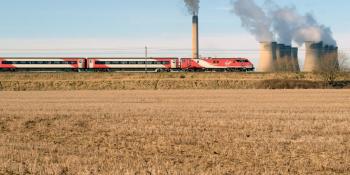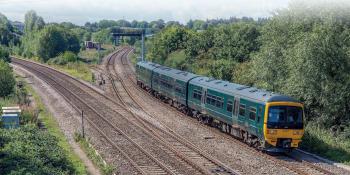Informed Sources
I’m giving her all she’s got, Captain! She cannae take any more


When the Office of Rail & Road was hearing submissions from Virgin Trains East Coast and potential open access operators for Long Distance High Speed (LDHS) paths on the East Coast main line (ECML), Network Rail was perceived as an obstacle to progress. The infrastructure operator was concerned that the increase in traction power demand from the electric trains running in the proposed additional paths would exceed the capability of the supply system. At that time Network Rail’s ability to model the ECML power supply network was struggling to keep up with the flood of proposals from the operators. But that was back in 2015. Four years on and Network Rail has a much better idea of the impact of new trains and timetables on traction power supply capability.
South of Doncaster the ECML power supply has already been strengthened under the Power Supply Upgrade 1 (PSU1) programme. PSU2 will cover the rest of the route and this is critical to future services.
PSU2 ISSUES
Working northwards, Doncaster is the first critical point. While the existing power supply copes with the mixture of electric and diesel traction foreseen when it was installed, an augmented all-electric service could not be supported. In addition to Class 800 Hitachi bi-modes replacing LNER’s IC125s, Hull Trains is also replacing its Class 180 DMUs with Class 802 bi-modes. FirstGroup has ordered Hitachi Class 801 EMUs for its London-Edinburgh open access service.
Fortunately, under the Department for Transport’s Intercity Express Programme (IEP), a new feeder station was required for Agility Trains East’s new depot at Doncaster, where the LNER Hitachi fleet will be maintained.
Even more fortunately, Northern Power Grid has already installed a new substation at nearby Potteric Carr, saving the cost of a dedicated connection for the new depot. And most fortunately of all, someone realised in time that the Potteric Carr feeder station could, with advantage, feed the main line as well as the depot.
Commissioning of Potteric Carr is scheduled for this month (June) and, allowing for any last-minute hiccups, Network Rail reckons it should be in operation for October (p55, April issue). Potteric Carr includes the first application of an innovation which will help reduce the cost of electrification, as well as improving efficiency and making the railway more acceptable to the Distribution Network Operators (DNO).
STATIC
Electricity distributed from power stations is three phase, high voltage. Hence the three cables you see between pylons. Railway 25kV electrification is single phase.
To provide this, the single-phase transformers at feeder stations have been connected across two phases of the incoming high voltage supply. This creates what is termed an ‘unbalanced load’, which is one reason why DNOs aren’t keen on railway electrification.

Potteric Carr has been equipped with an ABB static frequency converter (SFC) which connects to all three incoming phases, maintaining a balanced load. The SFC converts the incoming 33kV AC three-phase into DC and then back into 25kV AC single-phase for the overhead line equipment.
This is the first UK application of SFC technology, which is already used on European railways. ABB estimates that the SFC has saved 60% compared with the cost of providing a new high voltage grid connection for the site.
Technical approval of the SFC was imminent as this was being written early in May. As you can read in the Siemens supplement published with this issue, more SFC feeder stations are on their way to the route.
DONCASTER
Illustrating the fragility of the power supply in the Doncaster area, until Potteric Carr is commissioned, LNER will replace only a single IC125 diagram with an Azuma. Should commissioning be delayed, there is the possibility that IC125s might have to remain in service into 2020, with all that implies in terms of Persons with Reduced Mobility Technical Specification for Interoperability (PRM-TSI) compliance legislation.
Potteric Carr will provide the Doncaster area with sufficient power to run the 2021 timetable with its extra long-distance paths. However, the electrification engineers also have to reckon with temporary closures, or ‘outages’. Until the new Hambleton Junction feeder station (see below) is also operational, due by late 2020, the traction power supply will lack resilience in the event of an outage at Potteric Carr.
In the event of an outage the traction power supply would be able to accommodate up to four electric-powered trains per hour in each direction through Doncaster.
Above that number, bi-modes would have to change to diesel traction and electric trains terminate short. This is easily said, but in operational terms a prioritised list of services which would run under electric traction would have to be agreed with the train operators. For the bi-modes running through on diesel, a manual power changeover (MPCO) site would have to be introduced south of Bawtry to enable trains to switch back to electric traction without needing to reduce speed.
HAMBLETON
Moving north, the next critical location is the Hutton Bonville feeder station which supplies power to the ECML between Northallerton and Darlington. Modelling has shown that this can support the May 2019 Monday-to-Saturday timetable, including TPE’s new Class 802 units adding two trains an hour to LNER’s two electric services.
However, the supply cannot meet the 2021 timetable, which will require a brand-new feeder station at Hambleton Junction. This is a significant investment with a new 132kV DNO supply, and a Siemens feeder station including two SFCs. It is due to be commissioned by the end of November 2020.
That the power supply will be on the limit until then is demonstrated by the fact that Hutton Bonville alone will not be able to handle the five extra each-way London-Edinburgh services on Sundays. LNER has firm rights to operate today’s Sunday timetable while TPE has contingent rights to run a second hourly Liverpool-Newcastle service.
Until Hambleton Junction has been commissioned, on Sundays five bi-mode services in each direction will have to run through the Hutton Bonville feeding area on diesel traction. It is expected that Automatic Power Changeover (APCO) will be installed to switch the nominated services from electric to diesel power. However, to reduce costs and complexity, MPCO sites will suffice for diesel to electric changeovers.
That, of course, assumes that the trains run to timetable. Service perturbations can cause bunching, leading to more than the maximum four electric trains per hour running through the area. Contingency plans are being developed to cope with the risk of overload on the traction supply. However, this remains less than ideal, since managing the power load could make the perturbation worse.
BERWICK
Electrical power, as my physics teacher used to declare, is volts times amps. If trains are drawing lots of amps, and the power supply is constant, then the voltage will fall. Voltage in the overhead line can, and does, vary either side of the nominal 25kV. Electro-mechanical traction control systems were quite tolerant of such voltage variations. Modern trains, with power electronics under computer control, have become much more picky.
Traction power supplies in the Berwick area will be able to support two LNER electric services per hour in each direction, either InterCity 225 or Azuma trains. However, modelling predicts that power demand from even this modest service could pull the line voltage down to almost 18kV at times in the Innerwick and Marshall Meadows feeding areas. This is close to the minimum transient specified voltage of 17.5kV.
Low voltage would affect both the LNER fleets. But despite its apparent butchness, the ‘Mighty 91’ would be the hardest hit.
NO CHANCE
If the Innerwick and Marshall Meadows feeding areas are marginal today, there is no chance for LNER’s extra Sunday services to and from Edinburgh, plus the new First East Coast Trains all-electric open access service, plus TPE’s new bi-mode one train an hour Edinburgh service. Hence the requirement for an upgraded DNO supply at Marshall Meadows, also with static frequency converters.

Complicating the delivery timescale is the need for the DNO to obtain planning consents for the upgrade work. Construction will take around two years, which aligns with the 2021 timetable.
However, the consents process could add a year or more. Informed sources suggest that mid-2022 could be a more realistic aim.
Once again, Network Rail is having to consider a number of operating restrictions to mitigate the power limitations. For example, in the case of the extra Sunday services LNER could offset the additional power demand by running the equivalent number of bi-mode units through the Innerwick and Marshall Meadows feeding areas under diesel traction.
This will increase journey times compared with electric operation, and do not forget that DfT has vetoed running the Agility Trains East (LNER) Class 800 AGU diesel engines at their full commercial ratings because of the expense.
How long that decision will last when bi-modes replace IC125 north of Edinburgh is a separate issue. As with the Hutton Bonville feeding area, the aim would be to have temporary APCO sites to switch nominated services from electric to diesel power, with MPCO for the reverse procedure.
MITIGATION
Meanwhile, until the IC225s are withdrawn, one suggestion is that the risk of low line voltage affecting their performance could be further mitigated by LNER restricting the power drawn by its Class 80x trains to 70% of maximum through the Innerwick and Marshall Meadows feeding areas.
According to informed sources, train manufacturer Hitachi could implement this mitigation quickly through a database change. Even at 70% power the Azumas should be able to maintain HST and InterCity 225 sectional running times. And once InterCity 225s are withdrawn north of Newcastle, the database change could be reversed.
Once again, any bunching up of electric summits due to service disruption invalidates the modelling assumptions. Of course, the power supply can be managed in such cases – but, as already mentioned, this may further worsen performance.
Overall, while the 2019 ECML timetable is doable, the 2021 transformation is critically dependent on PSU2 being delivered on time. And note that, as Table 1 shows, I have listed only the major locations. PSU2 includes upgrades with new switchgear and SFC at feeder stations along the route.
With the benefits of the Intercity Express Programme already deferred from 2019 to 2021, the political stakes are high. Success will help revive the case for electrification across the network.






